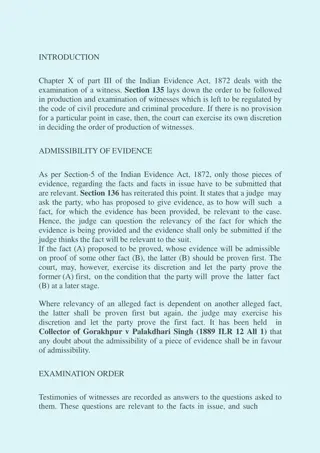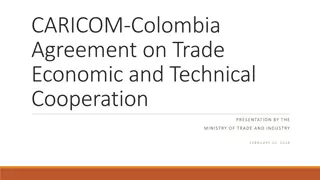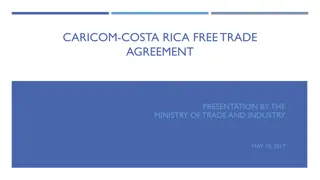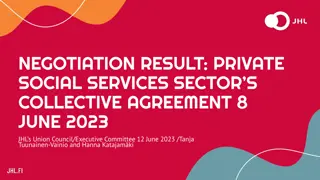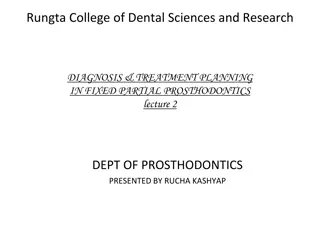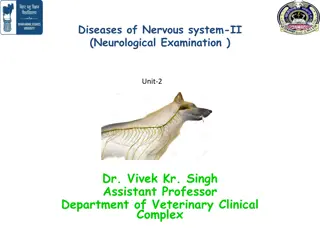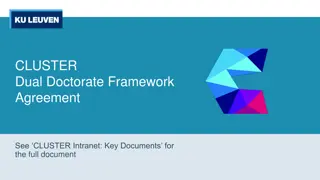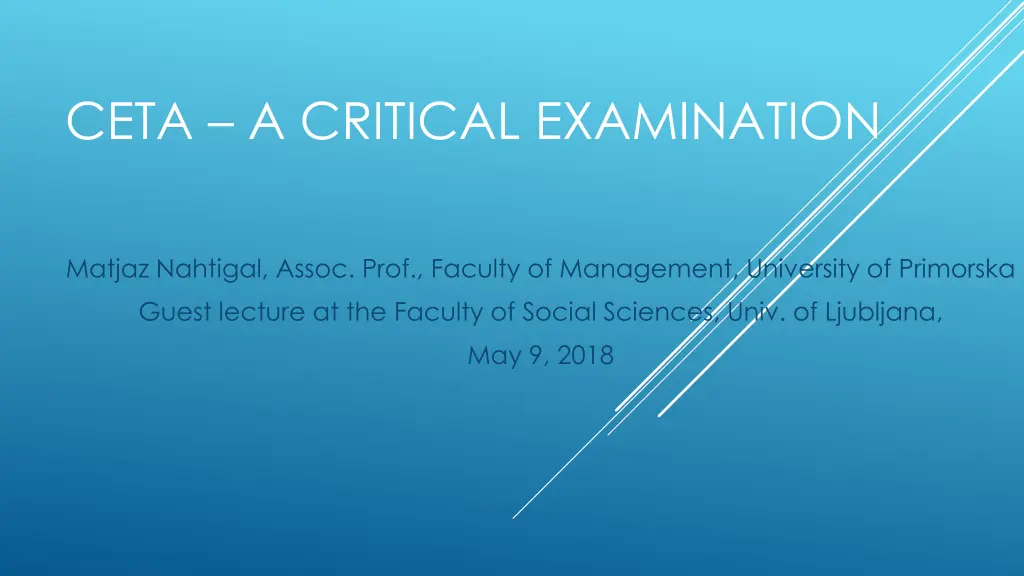
Critical Examination of Modern Free Trade Agreements
Explore the conceptual difficulties and deficiencies of modern free trade agreements like CETA, delving into issues of inclusiveness, equality, democratic participation, and regulatory harmonization. Learn about the potential outcomes and impacts on national incomes, as well as the contrasts between classical and modern free trade agreements such as NAFTA.
Download Presentation

Please find below an Image/Link to download the presentation.
The content on the website is provided AS IS for your information and personal use only. It may not be sold, licensed, or shared on other websites without obtaining consent from the author. If you encounter any issues during the download, it is possible that the publisher has removed the file from their server.
You are allowed to download the files provided on this website for personal or commercial use, subject to the condition that they are used lawfully. All files are the property of their respective owners.
The content on the website is provided AS IS for your information and personal use only. It may not be sold, licensed, or shared on other websites without obtaining consent from the author.
E N D
Presentation Transcript
CETA A CRITICAL EXAMINATION Matjaz Nahtigal, Assoc. Prof., Faculty of Management, University of Primorska Guest lecture at the Faculty of Social Sciences, Univ. of Ljubljana, May 9, 2018
CONCEPTUAL DIFFICULTIES WITH THE CETA AGREEMENT Any modern free trade agreement to meet the level of broad public legimitacy must achieve the following criteria: - to strengthen inclusiveness and equality of all the citizens; - to strengthen the rule of law; - to strengthen democratic participation. - Based on these three criteria, the CETA agreement is deeply questionable from procedural and substantive perspective.
CONCEPTUAL DEFFICIENCIES OF MODERN FREE TRADE AGREEMENTS The goal of deeper integration at the regional level (EU), at the transatlantic level (CETA and/or TTIP) and at the global level (WTO) should not be a simplified process of just removing the remaining trade barriers or achieving regulatory harmonization; - The regulatory harmonization is never a neutral process, it always creates strong redistributive effects among the participants (export vs. import firms, high skilled vs. low skilled workers; MNCs vs. SME companies, public goods vs. private interests ); - Therefore: the goal should be to create an environment, hospitable to institutional variety and diversity, tailor-made to the actual potential of each local, community, participating in the trade arrangement. - regional and national
THE KEY ISSUE: FREE TRADE CAN LEAD TO MULTIPLE OUTCOMES - Multiple outcomes with multiple equilibria (good, bad and mediocre) are possible trade is not always and automatically benign (Baumol and Gomory); - The gains from trade are not only a matter for individual firms or industries, they affect entire national incomes in various ways; - Moreover, modern comparative advantages are not inherited and they do not dependent on natural resources, in modern knowledge societies can comparative advantages be created and constructed, as pointed out by Unger.
CLASSICAL VS. MODERN FREE TRADE AGREEMENTS - Classical free trade agreements can lead to a zone of conflict, in which one country can increase its national income at the expense of a lower national income of its competitor; - The example of NAFTA as the first modern free trade agreements: highly unequal outcomes for different participants. The biggest losers of the NAFTA agreement are small Mexican farmers and low wage, low skilled Mexican workers in maquiladores , followed by the US low skilled workers; - There are many different ways to move from bad to good equilibrium, but this requires involvement and revision comprehensively represented. dynamic all and trading permanent partners, of the
CONCEPTUAL, PRACTICAL AND LEGAL DEFFICIENCIES OF THE CETA AGREEMENT Two experts on trade, economists Pierre Kohler and Servaas Storm, made economic analysis of the CETA agreement based on UN Global Policy Model. They pointed out that lack of intellectual diversity and realism shrouding the debate around CETA s alleged economic benefits. Unlike the neoclassical CGE model their analysis led to the conclusion that CETA would lead to net losses in terms of employment, personal incomes and GDP in Canada and to a relatively lesser extent the EU. In particular, about 230 thousand jobs would be lost in CETA countries, 200 thousand of them in the EU, and 80 thousand more in the rest of the world, adding to the already declining labor income share. In the long run, slower wage increases will transfer an additional share of national income from labor to capital owners See http://www.ase.tufts.edu/gdae/Pubs/wp/16-03CETA.pdf more in Kohler, Storm, CETA Without Blinders, TUFTS 2016:
PRACTICAL DEFFICIENCIES According to the judgment of the German Constitutional Court with respect to CETA, the Federal German Government must ensure: - that a Council decision on provisional application will only apply to those parts of CETA that lie indisputably within the scope of the competences of the European Union, - that until the Federal Constitutional Court renders a decision in the principal proceedings, sufficient democratic legitimacy with regard to the decisions of the CETA Joint Committee is ensured, and - that the interpretation of Art. 30.7 sec. 3 lit. c CETA allows Germany to unilaterally terminate the provisional application. See: https://www.bundesverfassungsgericht.de/SharedDocs/Pressemitteilungen/EN/2016/bvg16-071.html See also: https://www.iisd.org/itn/2016/12/12/only-a-brief-pause-for-breath-the-judgment-of-the-german-federal- constitutional-court-on-ceta-jelena-baumler-baeumler/ And: court/ http://borderlex.eu/national-courts-eu-trade-policy-powers-eu-canada-trade-deal-german-constitutional- Discussion: is the veto power over certain CETA provisions reserved only for Germany in the EU context? What about other EU members and regions, for example Wallonia?
OTHER LEGAL, SOCIO-ECONOMIC AND ENVIRONMENTAL CONCERNS In addition to ISDS (ICS) provision there are many other equally of perhaps even more important controversial points in the agreement, divided into 30 chapters and annexes. Other important controversial parts of the agreement: accelerated regulation for business, but not for strengthening public goods, such as health, environment, social protection. Further liberalization of public services. Limitations of regulatory autonomy, because it must be in compliance with CETA framework. Example: Article 12. 3. 7: Each Party shall ensure that licensing procedures or qualification procedures it adopts or maintains are as simple as possible, and do not unduly complicate or delay the supply of a service, or the pursuit of any other economic activity Constraints in domestic industrial policies (chapters on subsidies and regulatory cooperation), vague safeguards to protect workers rights, environment No compensation foreseen for the regions and countries that may need to structurally adjust due to trade liberalization.
CETA OVERESTIMATES BENEFITS AND UNDERSTIMATES WELFARE LOSSES As an unbalanced agreement, skewed toward corporate benefits at the expense of public goods, CETA cannot be viewed as a modern free trade agreement according to the criteria stated in SLIDE 2. It underestimates costs of the agreement. is fragmented agreement that overestimates benefits and It is very likely that it would further concentrate economic wealth, power and welfare in the privileged segments of the EU.
DISCUSSION How to design modern free trade agreements that would lead toward more balanced, more inclusive and more sustainable development for ALL participants? Discussion from the procedural, substantive and normative point of view, while taking into account that simple compensation for welfare losses no matter how welcome cannot present a sufficient answer. More policy space, more capacity to articulate and implement bottom-up development strategies and institutional innovations should present the first step toward more balanced future trade agreements, regional, trans- Atlantic and global. Preventing race to the bottom and beggar-thy- neighbor policies should be embedded in any future trade agreements.











